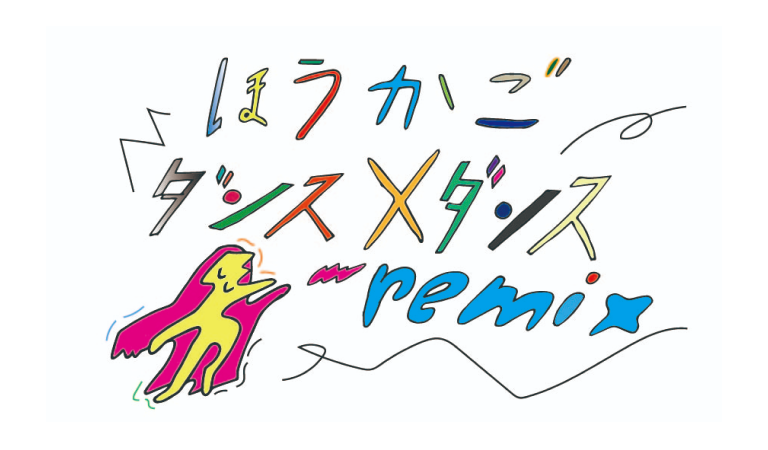ADD Minato City
Document of the Research and Workshops
Mari Fukutome, Mikico Suto and Daisuke Muto
Research
With embassies of many countries and many foreigners, Minato City is like having the whole world in Tokyo. We walked around Azabu, where the ADD Minato City's base, the Azabu Kids-to-Teens Hall, is located, and through the cooperation and connections of many people, we were able to find a variety of dances.
First, we went to the city center and library to gather information. Various dance class information and some interesting flyers were noticed.
The "Minato City World Festival" was an event that involved visiting embassies. At the embassies, we were able to listen to stories about the dances of various countries. There was also an event at the Tokyo Tower where you could see traditional dances from around the world, and we were particularly impressed by the colorful folk dances of Uzbekistan and Afghanistan. Although the Middle East has a heavy image of war, the richness of the culture rooted in people's daily lives could be experienced.
We were also surprised to learn that bon dance is very popular in Minato City. When we went to Shiba Park after finding a flyer for the "Bon Dance Festival of Local Songs Discovered in Minato City", many people gathered and danced "Shibaura Ondo", "Tokyo Gorin Ondo 2020" and others, one after another. Yukiko Kitajima, a representative of the "Bon-Odori Executive Committee that Cheers up the People and the Community" told us about the event, and later we visited a practice session. 50 to 60 people, ranging from the elderly to office workers and junior high school students, danced for two hours and a half straight.
The multifaceted nature of Minato City, with its rich international flavor and vibrant traditional Japanese culture, came to light through dance.
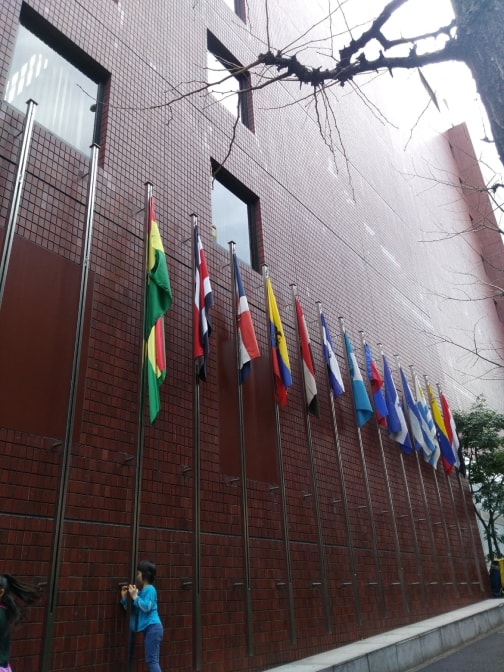
One building may contain multiple embassies.
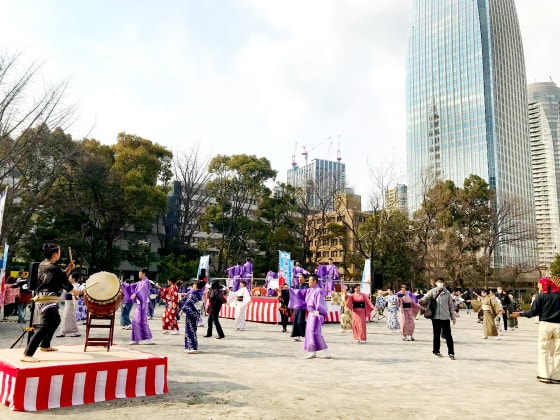
"Bon Dance Festival of Local Songs Discovered in Minato City" moderated in Japanese-English bilingual.

Steel reinforced concrete building "Arimaston Building", built by Keisuke Oka on his own.
Workshop
The base of the ADD Minato City is the "Azabu Kids-to-Teens Hall". Children of all ages and nationalities gather here after school, creating a lively atmosphere. There are facilities for play, sports, and games, as well as a wide variety of events and club activities. ADD's workshop "Hôkago Dance x Dance remix" was held here among them. Not only those who signed up in advance, but also many children who were passing by and were interested in what we were doing joined the workshop.
Chisato Watanabe, a staff member of the Hall, said that the most important thing is the children's desire to try it out, and that the presence of adults who can make it look like they are having fun is very important to draw them out. Chisato enjoyed being involved in the project herself.
There are so many different people involved in dance in Minato City that the workshop had a wide variety of content.
Yukiko Kitajima, who has been promoting the bon dance culture rooted in the community, taught us various bon dances and also introduced us to Izumi Kojima, who is engaged in a wide range of sign language activities and incorporates dance as well. Sign language, which conveys meaning through the shape of the hands, seems to have something in common with classical Japanese dance.
Sayaka Masaki, a flamenco dancer, taught us the basic 12-beat steps with Satoru Hirashima, a cajón player. The children looked bewildered at first, but as they repeated the steps over and over, their movements naturally came together to form the vigorous movements that only flamenco can offer.
Takahiro Iwai taught us the basics of popping (one of the street dances), a technique in which the movement is halted abruptly by flicking the muscles. The trick is to imagine that you are grabbing something in the air. Once the children learned it, they were able to play (and dance) with it immediately.
Capoeira, taught by Ryu Shirahase, is a traditional Brazilian culture that is a mixture of dance and martial arts. After learning the basic techniques, we tried roda, which is a one-on-one exchange of moves in a circle to the rhythm of a single string percussion instrument called berimbau.
Ashraf Baburi of the Embassy of Afghanistan, saying at first that he was not a good dancer, taught us a folk dance called attan, which resembles bon dance, wearing a neat traditional costume. Nanako Kamimura,the leader of the Afghan dance group "Sharan Sharan", also demonstrated the beautiful female dance for us. Their gorgeous costumes were very popular among the children, who lined up for photos after the workshop.
Three mothers trained in ballet, "Uni mama" taught the children "body work", and researcher Mari Fukutome taught them how to move as an extension of "play", both giving them a taste of what comes before "dance".
The classical Japanese dance workshop was conducted by Kikunojo Onoe, the iemoto of the Onoe school. Wearing tabi (split-toed socks), the children learned how to greet each other, how to handle a fan, and how to behave and prepare for the dance. Kikunojo's graceful and delicate attitude seemed directly touching the children. In classical Japanese dance, gestures are used to express meanings, which are then combined to act out a story. The children enjoyed expressing "snow falling" and "wind blowing" with a fan and experienced Japanese traditional culture and aesthetic sense.
In addition to the above-mentioned people, we were able to meet many other unique people whose workshops were not carried out due to the pandemic, such as Hiromi Hamada, who is from Okinawa and teaches Ryukyuan dance, Keisuke Oka, who is constructing a self-built building in Mita called "Arimaston Building" and is also a butoh dancer, and Naoto Kawakami, who is a father of an elementary school student attending the Hall and is also a break dancer.

The community of bon dance lovers is very active. Their lesson for children is powerful.

The basic capoeira move called ginga, with the extensive body movement to get into the rhythm.

Attan is an Afghan circle dance enjoyed at weddings and other occasions.
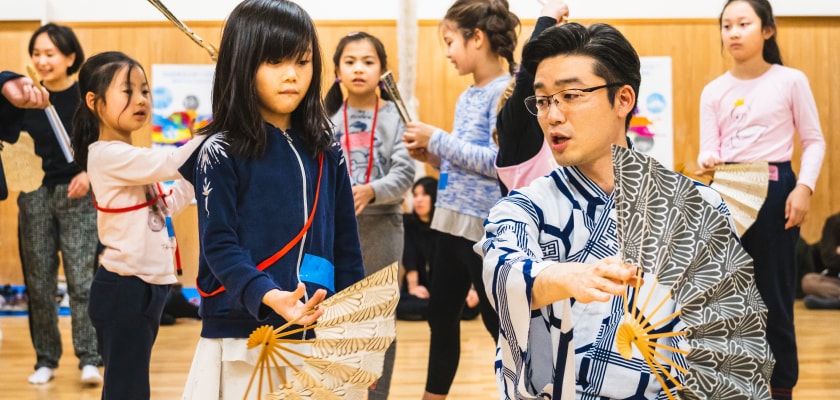
Classical Japanese dance has a highly theatrical nature, which makes It distinct from other dances. The children had a firsthand lesson from Kikunojo Onoe.

Feedbacks from the children after the workshop.
Workshop (Resumed)
After the seventh workshop in Minato City, we were forced to suspend the program due to the COVID-19 pandemic. After a one-year and four-month hiatus, we restarted the program with a four-day short-term program and invited children to participate. Of the six children who gathered, four were participating for the first time.
Mikico Suto, who took over from Mari Fukutome, served as the facilitator, and the children learned the rudiments of capoeira from Ryu, flamenco from Sayaka, sign language from lzumi, classical Chinese dance from Lei Huang, and classical Japanese dance from Kikunojo. Lei, who was making her first appearance in the program, taught them how to move fluidly while being conscious of their breathing, in contrast to other dances that are based on rhythm. Furthermore, Kikunojo's idea was to use Choju-Giga (Scrolls of Frolicking Animals) as the overall motif of the showing, so the children also learned the movements of animals in each dance (bull in flamenco, monkey and frog in capoeira, bird in classical Chinese dance, and rabbit and raccoon in classical Japanese dance).
At the beginning of each class, in addition to the demonstrations by the instructors, the historical background of the dances was introduced so that the participants would be interested in the cultural aspects of the dances.
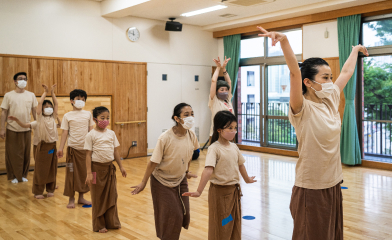
Lei, a former boarding student at Chinese national dance troupe since her childhood, teaches the children the dance.
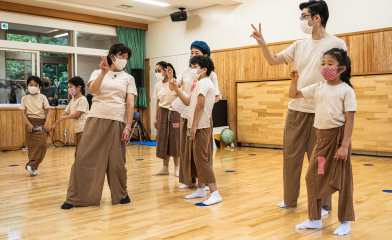
Experiencing sign language. Kikunojo was also intrigued, noting the similarity to classical Japanese dance.
Showing
The stage and audience were set up in the gymnasium (arena) in the plaza, and the children performed the dances they had learned one by one with their instructors, inviting their parents and other related people to join the audience. At the beginning of the performance, the children used sign language to express the title, "Minato-ku Choju-Giga".
The children, dressed in matching costumes dyed in ink-painting style in reference to the Choju-Giga, stood on the lighted stage and performed with a good deal of tension and concentration against the backdrop of live music of cajón, guitar and drums. The second half of the performance was a game style, with the children randomly selecting and dancing the movements they had learned, and then for the finale, they danced in a circle with their original animal movements, to the delight of the audience.
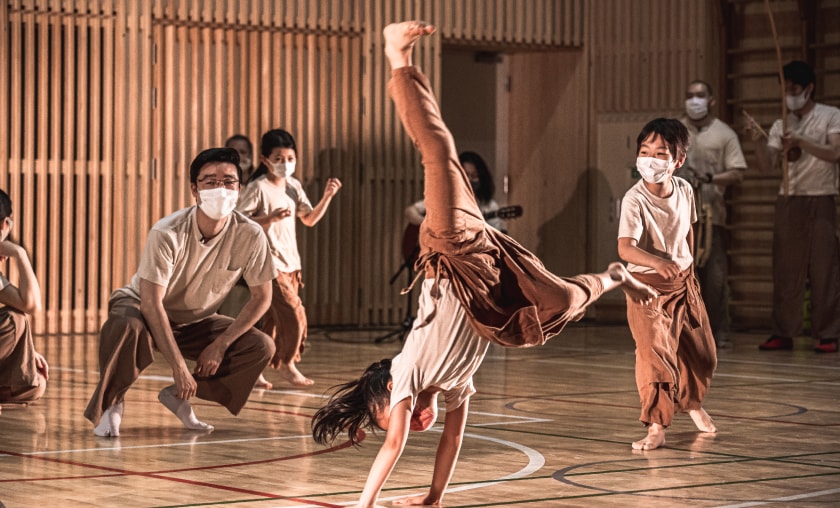
Adults and children alike enjoy diving into uncharted waters.
